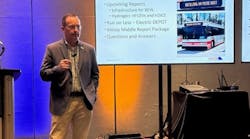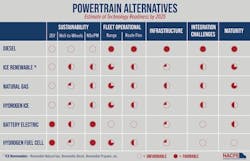NACFE report: Waiting is no longer an option' for realistic Emissions Reductions in Trucking
ORLANDO, Florida—During what the North American Council for Freight Efficiency (NACFE) deems “the messy middle,” fleets will be faced with several powertrain options, including advanced diesel, renewable fuels, natural gas, hydrogen, hybrids, battery electric power, and hydrogen fuel cells, with no one right solution for all duty cycles.
“Trucking is decarbonizing,” Mike Roeth, NACFE’s executive director, pointed out during American Trucking Associations’ 2023 Technology & Maintenance Council (TMC) Annual Meeting. “We are doing it in a lot of different ways—from better efficiency in diesel trucks, going to zero with battery-electric and hydrogen, and then looking at these alternatives in the messy middle.”
During TMC, NACFE released a new report, “The Messy Middle: A Time For Action,” that provides fleets with a data-based framework on which to base their powertrain decisions.
Jeff Seger, the lead author of NACFE’s report, broke down some of the factors that fleets must consider during this period. Those factors include economics in terms of fuel and energy prices, regulations, and sustainability goals for fleets and their customers, Seger noted.
"The messy middle is applicable to all commercial vehicles, but we're targeting long-haul Class 8—that's kind of the tough nut to crack in terms of decarbonization," Seger explained.
"The model is clearly changing for fleets—from get it there on time at the lowest cost to get it there on time at lowest cost but in an environmentally friendly way," he added. "That's the whole challenge we are trying to address."
Click here to see the full story in Fleet Owner
NACFE will be a key contributor to content on E-Mobility at T&D World Live
Most Utility-involved Event in the U.S.: Happening September in Sacramento
Messy isn't a bad thing
While the messy middle can be complicated, NACFE representatives emphasized that they do not view messy as bad, but rather see it as a time when fleets will want to act, will have to evaluate many options, and will need to look beyond just the truck to the infrastructure needed to support that truck. Seger added that the messy middle represents a period in which fleets will have a lot of options and a lot of decisions to make.
In its report, NACFE attempted to compare the different types of powertrains being offered and the key factors for fleets to consider when making the decision about which power options are right for them now and in the future. It also includes a framework for powertrain decisions fleets can use to evaluate their options.
"We're trying to simplify a lot of the complexity," Seger said, pointing out that solutions and information will continue to evolve and look different over time.
For instance, diesel remains the gold standard today in terms of availability, infrastructure, and range, whereas battery-electric and hydrogen fuel cell are the gold standard in terms of zero emissions (see NACFE's powertrain chart below), according to NACFE. However, Seger noted, when it comes to well-to-wheel production for battery-electric and hydrogen fuel cell vehicles, the industry needs to consider how green or sustainably sourced those materials actually are.
"Battery-electric and hydrogen fuel cell are part of the messy middle and part of this timeframe when we are figuring it out," Roeth said. "There might be some high-risk, high rewards for fleets in this, where those that pick the right technology for their business are going to be successful, but if you pick the wrong one, it's going to be challenging."
With that in mind, NACFE created a framework that starts with looking at battery-electric trucks and then moving to other options if battery-electric or hydrogen fuel cell options aren't viable solutions for specific fleet duty cycles and operations.
Roeth suggested in those cases fleet might consider hybrid or other sustainable options that fall in line with a fleet's financial situation, sustainability, and the availability of one option over another based on business operations.
"You can't stick your head in the sand," Roeth urged. "If that final piece of the framework for your fleet is diesel, then we suggest that you get very aggressive with efficiency (for instance, aerodynamics, low-rolling resistance tires, etc)."
The primary conclusion of the report is that it is now time for fleets to act and begin to wade into the messy middle to get to a zero-emissions future. "Waiting is no longer an option," according to NACFE.
About the Author
Cristina Commendatore, Editor in Chief, Fleet Owner
Cristina Commendatore is the Editor in Chief of FleetOwner magazine. She has reported on the transportation industry since 2015, covering topics such as business operational challenges, driver and technician shortages, truck safety, and new vehicle technologies. She holds a master’s degree in journalism from Quinnipiac University in Hamden, Connecticut.

